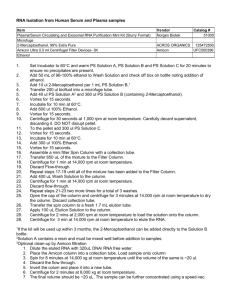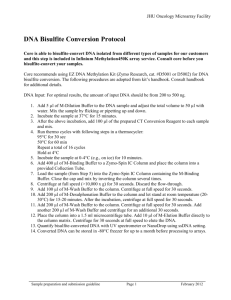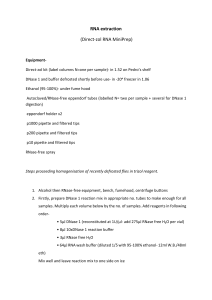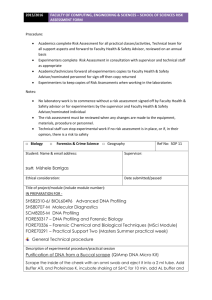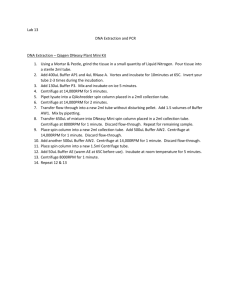Manual
advertisement
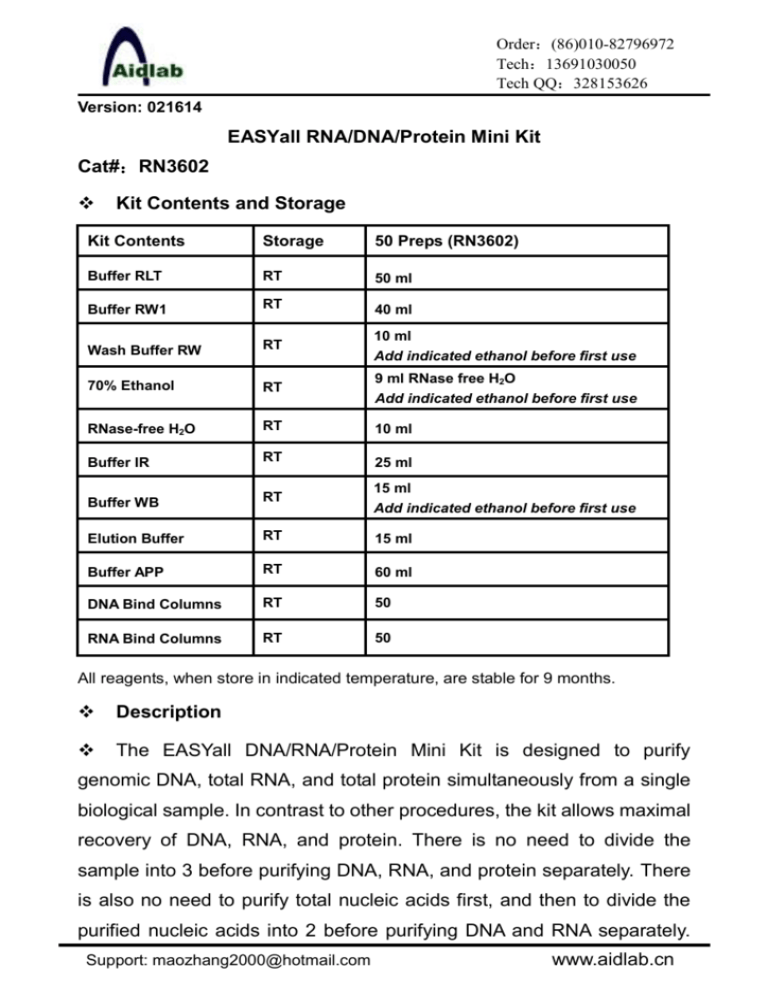
Order:(86)010-82796972 Tech:13691030050 Tech QQ:328153626 Version: 021614 EASYall RNA/DNA/Protein Mini Kit Cat#:RN3602 Kit Contents and Storage Kit Contents Storage 50 Preps (RN3602) Buffer RLT RT 50 ml Buffer RW1 RT 40 ml Wash Buffer RW RT 10 ml Add indicated ethanol before first use 70% Ethanol RT 9 ml RNase free H2O Add indicated ethanol before first use RNase-free H2O RT 10 ml Buffer IR RT 25 ml Buffer WB RT 15 ml Add indicated ethanol before first use Elution Buffer RT 15 ml Buffer APP RT 60 ml DNA Bind Columns RT 50 RNA Bind Columns RT 50 All reagents, when store in indicated temperature, are stable for 9 months. Description The EASYall DNA/RNA/Protein Mini Kit is designed to purify genomic DNA, total RNA, and total protein simultaneously from a single biological sample. In contrast to other procedures, the kit allows maximal recovery of DNA, RNA, and protein. There is no need to divide the sample into 3 before purifying DNA, RNA, and protein separately. There is also no need to purify total nucleic acids first, and then to divide the purified nucleic acids into 2 before purifying DNA and RNA separately. Support: maozhang2000@hotmail.com www.aidlab.cn The kit is compatible with small amounts of a wide range of cultured cells and harvested tissues of animal and human origin. The EASYall DNA/RNA/Protein Mini Kit allows the parallel processing of multiple samples. Methods involving the use of toxic substances such as phenol and/or chloroform, or time-consuming and tedious methods such as alcohol precipitation, are replaced by the EASYall DNA/RNA/Protein procedure. The EASYall DNA/RNA/Protein procedure combines spin column RNA/DNA tech with a new protein precipitation chemistry. Efficient purification of high-quality DNA, RNA, and proteins is guaranteed, without the need for additional RNase and DNase digestions(Samples with particularly high DNA content may require additional DNase digestion.). Features 1. Maximal recovery of each analyte from precious samples 2. Time savings through short, streamlined workflow 3. Comparable data as analytes come from same sample 4. No need for organic solvents such as phenol and acetone Procedure Note: Before the first use, add the indicated amount of ethanol into Wash Buffer RW、Buffer WB and 70% ethanol bottles, mix well, and mark the bottle with a check. Do not overload the EASYall DNA bind column, as this will lead to copurification of DNA with RNA. Do not overload the RNA bind column, as this will significantly reduce RNA yield and purity. 1. Culture cells: a. Harvest <107 cells grown in suspension into a centrifuge tube. Adherent cells can be lysed directly in cell-culture vessels or trypsinized from culture flasks and collected into a centrifuge tube. b. Centrifuge at 13,000 rpm for 10 sec (or 800 rpm for 5min) to pellet cells. Completely aspirate the supernatant. Note: Incomplete removal of the supernatant will decrease the yield Support: maozhang2000@hotmail.com -1- www.aidlab.cn and purity. c. Loosen the cell pellet thoroughly by flicking the tube. Add 350 µl (<5x106 cells) or 600 µl (5x106-1x107 cells) of Buffer RLT, pipet or vortex to mix. d. Homogenization: (cells <1x105 can be homogenized by vortexing for 1 min.) Pass the lysate at least 5 times through a 20-gauge needle (0.9 mm diameter) fitted to an RNase-free syringe. Homogenization shears genomic DNA, reduces the viscosity of the lysates, and increases the yields. e. Apply the homogenized lysate to a DNA bind column placed in a 2 ml collection tube (supplied). f. Immediately proceed to Step 3. 2. Animal tissues (for example, mouse liver and brain): a. Mince fresh tissues into small pieces, add 350 µl (<20 mg tissue) or 600 µl (20-30mg tissue) of Buffer RLT. Homogenize with electronic tissue homogenizer for 20-40 s. Or b. Immediately place the tissue in liquid nitrogen, and grind thoroughly with a mortar and pestle. Transfer adequate amount (20mg/30mg) of tissue powder in to a 1.5 ml microcentrifuge tube containing 350 µl/600 µl of Buffer RLT, vortex for 20 s. Pass the lysate at least 5 times through a 20-gauge needle (0.9 mm diameter) fitted to an syringe or homogenize with an electronic tissue homogenizer. This step shears genomic DNA, reduces the viscosity of the lysates, and increases the yields. c. Centrifuge the homogenized lysate at 13,000 rpm for 3 min. Transfer the supernatant into a DNA bind column carefully in a supplied 2 ml collection tube. d. Immediately proceed to Step 3. 3. Centrifuge at 13,000 rpm for 60 s, and save the flow-through (RNA Support: maozhang2000@hotmail.com -2- www.aidlab.cn is in the flow-through). Ensure all the samples flow through the column. Increase centrifuge speed and time, if necessary. 4. Place the DNA spin column in a new 1.5 ml micro tube ( not supplied), and store at room temperature (15–25°C) or at 4°C (do not freeze) for later DNA purification in steps 20–23. Use the flow-through for RNA purification in steps 5–11. Total RNA purification 5. Add equal volume of 70% ethanol (usually 350 µl/600 µl, adjust the ethanol volume accordingly if some lysate is lost during the above procedure) and pipet to mix immediately. Precipitation may be formed after the addition of ethanol, but this does not affect the procedure. Do not centrifuge. 6. Transfer up to 700 µl mixture into a RNA bind column placed in a 2 ml collection tube (supplied). Centrifuge at 13,000 rpm for 30 s, and transfer the flow-through to a new 2 ml tube (not supplied) for protein purification in steps 12–19. Keep the collection tubes for later DNA purification in steps 20–23. If the sample volume exceeds 700 μl, centrifuge successive aliquots in the same RNA bind column. Transfer the flow-through after each centrifugation. 7. Add 700 µl Buffer RW1, and incubate at room temperature for 1 min. Centrifuge at 12,000 rpm for 30 s. Discard the flow-through. 8. Add 500 µl Wash Buffer RW, and centrifuge at 12,000 rpm for 30 s. Discard the flow-through. Repeat Step 8 with another 500 µl Wash Buffer RW. 9. Place the RNA bind column back into the same collection tube. Centrifuge the empty column at 13,000 rpm for 2 min to completely remove ethanol from the column. 10. Place the column in a RNase free microcentrifuge tube. Add 30-50 Support: maozhang2000@hotmail.com -3- www.aidlab.cn µl of RNase free water (Optional: pre-warm the water to 70–90C will increase the RNA yield) to the center of the column membrane. Incubate at room temperature for 1 min, and centrifuge at 12,000 rpm for 1 min to elute the RNA. 11. If the expected RNA yield is >30 μg, repeat step 10 with another 30–50 μl of RNase-free water, or using the eluate from step 10 (if high RNA concentration is required). Reuse the centrifuge tube from step 10. If using the eluate from step 10, the RNA yield will be 15–30% less than that obtained using a second volume of RNase-free water, but the final RNA concentration will be higher. Total Protein purification 12. Add 1 volume of Buffer APP to the flow-through from step 6. Mix vigorously and incubate at room temperature for 10 min to precipitate protein. 13. Centrifuge at full speed for 10 min, and carefully decant the supernatant. 14. Add 500 μl of 70% ethanol to the protein pellet. Centrifuge at full speed for 1 min, and remove the supernatant by using a pipet or by decanting as much liquid as possible. It is not necessary to resuspend or incubate the pellet. 15. Centrifuge at full speed for 10 min, and carefully decant the supernatant. 16. Dry the protein pellet for 5–10 min at room temperature. Note: Incomplete drying may cause problems when loading the protein onto a gel due to residual ethanol. 17. Add 30-150 μl 1 x concentration of Sample buffer( no bromophenol blue dye if need protein quantification) and mix vigorously to dissolve the protein pellet. If the proteins will not be analyzed by Support: maozhang2000@hotmail.com -4- www.aidlab.cn SDS-PAGE, dissolve the pellet in a buffer compatible with the intended downstream application. Note:Due to the strong denaturing conditions with Buffer RLT, which is necessary to inactivate RNases and proteases, the precipitated proteins may show reduced solubility. Vortex for several minutes or disaggregate the pellet by pipetting up and down several times.For easier dissolving or if the proteins need to be quantified prior to SDS PAGE, dissolve the pellet in 5% (w/v) SDS or 8 M urea. Protein dissolved in SDS or urea solutions can be quantified using the BCA (bicinchoninic acid) method, but there must be no dye in the solutions. Protein in 5% (w/v) SDS can be used directly with the method, but protein dissolved in 8 M urea must be diluted to give 3 M urea. 18. Incubate for 5 min at 95°C to completely dissolve and denature the protein. Then cool the sample to room temperature. 19. Centrifuge for 1 min at full speed to pellet any residual insoluble material. Use the supernatant in downstream applications such as SDS-PAGE and western blotting. The dissolved protein can be stored at –20°C for several months or at 4°C for several days. Genomic DNA purification 20. Put the DNA bind column from step 4 back to collection tube from step 6 . Add 500 μl Buffer IR and centrifuge at 12,000 rpm for 30 s to wash the spin column membrane. Discard the flow-through. 21. Add 600 µl Buffer WB, and centrifuge at 12,000 rpm for 30 s. Discard the flow-through. Repeat Step 21 with another 600 µl Buffer WB. 22. Place the spin column back into the same collection tube. Centrifuge the empty column at 13,000 rpm for 2 min to completely remove ethanol from the column. Support: maozhang2000@hotmail.com -5- www.aidlab.cn Note: It is important to dry the membrane of the spin column, since residual ethanol may interfere with subsequent reactions. This centrifugation step ensures that no residual ethanol will be carried over during the following elution. 23. Place the column in a clean 1.5 ml microcentrifuge tube. Add 100 µl of Elution Buffer (Optional: pre-warm the water to 70–90C will increase the DNA yield) to the center of the column membrane. Incubate at room temperature for 2-3 min, and centrifuge at 12,000 rpm for 1 min to elute the DNA. Note: Use smaller volume(minimum 30µl) of Elution Buffer will obtain higher concentration. Optional: Put eluate back to the spin column to repeate elution once. This increases concentration of DNA about 10-15% Support: maozhang2000@hotmail.com -6- www.aidlab.cn

